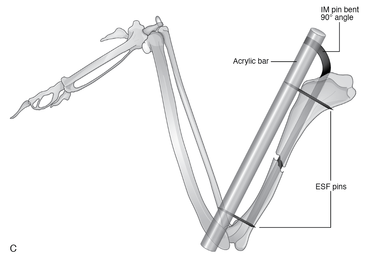A large percentage of raptors admitted to rehabilitation centers world-wide have sustained traumatic fractures of their long bones. Bird bones are challenging to work with because of their thin, brittle walls, curvatures, and the need for post-operative patients to have full mobility.
For the first 20 years at The Raptor Center (TRC), intramedullary pins (pins placed into the “hollow” cavities of bird bones) or external fixators, often accompanied by some form of splinting, were the usual methods used to repair avian fractures. Success was had in some cases, but failures were all too frequent. In the early 1990s, the external fixator was re-imagined by a group of private small animal orthopedic surgeons. It was revolutionary and forever changed the way orthopedic surgery was conducted and trained at TRC.

| Figure from Avian Medicine, third edition
Originally designed for small domestic animals, the “tie-in” fixator needed considerable modification to be utilized effectively in birds. This idea was envisioned at TRC, “tying” the external fixator components to an intramedullary pin using a bar made of heated flexible acrylic that would harden when cooled. This yielded an incredibly robust, durable, and well- tolerated mode of fixation.
The first case in which the new tie-in fixator was used was to repair a humeral fracture in a bald eagle. To the staff’s astonishment, healing of that fracture was complete in under three weeks— nearly twice as fast as anything previously experienced. Further refinement of this technique by TRC clinicians followed and the success rate of orthopedic repairs in birds soared from around 25 percent to more than 75 percent.
The method was and still is the primary approach to fracture repair at TRC and much of the world, leading to the recovery of many thousands of injured raptors globally.